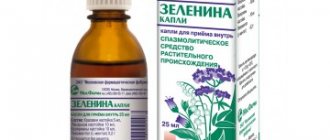Zodak allergy medicine drops for oral administration 10mg/ml 20ml
A country
Germany
The country of production may vary depending on the batch of goods. Please check with the operator for detailed information when confirming your order.
Active substance
Cetirizine
Compound
The active ingredient is cetirizine.
pharmachologic effect
Antihistamine, antiallergic. Selectively blocks peripheral histamine H1 receptors, weakens the effect of histamine on blood vessels, reduces hyperemia and swelling. Effectively inhibits the development of skin reactions (blister and hyperemia) to the introduction of histamine, specific allergens, cooling (in patients with cold urticaria). The effect appears within 1-2 hours after administration, the duration of blockade of H1 receptors reaches more than 24 hours, in newborns and children under 2 years old - about 12 hours. It alleviates the symptoms of allergic rhinitis (sneezing, runny nose, nasal congestion, itching, lacrimation). Dose-dependently weakens histamine-induced bronchoconstriction in mild bronchial asthma. Inhibits the development of the histamine-mediated early phase of the allergic reaction. Food intake does not affect the completeness of absorption. It is minimally metabolized in the liver to form an inactive metabolite and is excreted unchanged primarily by the kidneys. Passes into breast milk.
Indications for use
Seasonal and year-round allergic rhinitis, hay fever, allergic conjunctivitis, chronic idiopathic urticaria, itching, angioedema; complex therapy of atopic dermatitis, chronic eczema, bronchial asthma.
Mode of application
Adults and children over 12 years old - 20 drops 1 time per day, at night. Children aged 6-12 years - 10 drops in the morning and evening or 20 drops in the evening. Children aged 2-6 years - 10 drops in the evening or 5 drops morning and evening. Children aged 1-2 years, 5 drops morning and evening.
Interaction
Theophylline slightly reduces clearance. Compatible with azithromycin, pseudoepinephrine, ketoconazole, erythromycin, diazepam and cimetidine.
Side effect
From the nervous system and sensory organs: drowsiness, fatigue, agitation, headache, dizziness, anxiety, nervousness, emotional lability, impaired concentration and thinking, insomnia, depression, euphoria, confusion, amnesia, depersonalization, ataxia, impaired motor coordination , tremor, hyperkinesis, calf muscle cramps, paresthesia, dysphonia, myelitis, paralysis, ptosis, impaired accommodation and vision, eye pain, glaucoma, xerophthalmia, conjunctivitis, hemorrhage in the eye, ototoxicity, tinnitus, deafness, impaired sense of smell. From the gastrointestinal tract: dry mouth, change or absence of taste perception, increased appetite, anorexia, stomatitis (including ulcerative), discoloration and swelling of the tongue, increased salivation, increased caries, thirst, vomiting, dyspepsia, gastritis, pain in abdomen, flatulence, diarrhea, constipation, hemorrhoids, melena, rectal bleeding, liver dysfunction. From the cardiovascular system: migraine, extremely rarely - palpitations, hypertension, heart failure. From the respiratory system: rhinitis, nosebleeds, nasal polyp , pharyngitis, cough, sinusitis, bronchitis, increased bronchial secretion, bronchospasm, dyspnea, upper respiratory tract infection, pneumonia, hyperventilation. From the genitourinary system: urinary retention, edema, polyuria, dysuria, hematuria, urinary tract infection, cystitis, decreased libido , dysmenorrhea, intermenstrual bleeding, menorrhagia, vaginitis. From the musculoskeletal system: arthralgia, arthritis, arthrosis, myalgia, back pain, muscle weakness. From the skin: dry skin, rash, blistering rashes, itching, acne, furunculosis , dermatitis, eczema, hyperkeratosis, erythema, increased sweating, alopecia, angioedema, hypertrichosis, photosensitivity, seborrhea. Others: malaise, fever, chills, hot flashes, dehydration, diabetes mellitus, lymphadenopathy, breast pain, weight gain, skin allergic reactions, incl. hives.
Contraindications
Hypersensitivity, including to hydroxyzine, pregnancy, breastfeeding, children under 2 years of age (up to 6 years with impaired renal or liver function). Restrictions on use: Impaired renal and liver function, old age.
Overdose
Symptoms: drowsiness, possible anxiety, urinary retention, tremor, tachycardia, itching, rash. Treatment: gastric lavage, administration of activated charcoal; supportive and symptomatic therapy. Hemodialysis is ineffective.
special instructions
The concomitant use of CNS depressants and alcohol consumption is not recommended. Use with caution while working for vehicle drivers and people whose profession involves increased concentration.
Zodak allergy medicine tablets No. 30
A country
Czech Republic
Country of production may vary depending on the batch of goods. Please check with the operator for detailed information when confirming your order.
Active substance
Cetirizine
Compound
1 tablet contains: cetirizine dihydrochloride 10 mg. Excipients: lactose monohydrate - 73.4 mg, corn starch - 33 mg, povidone 30 - 2.4 mg, magnesium stearate - 1.2 mg. Film-coated tablets are white or almost white, oblong, with risky for dividing on one side.
pharmachologic effect
Cetirizine is a metabolite of hydroxyzine, belongs to the group of competitive histamine antagonists, blocks histamine H1 receptors, has virtually no anticholinergic and antiserotonin effects. It has a pronounced antiallergic effect, prevents the development and facilitates the course of allergic reactions: at a dose of 10 mg 1 or 2 times a day, it inhibits late phase of eosinophil aggregation in the skin and conjunctiva of patients susceptible to atopy. Has antipruritic and antiexudative effect. Affects the early stage of allergic reactions, and also reduces the migration of inflammatory cells; inhibits the release of mediators involved in a late allergic reaction. Reduces capillary permeability, prevents the development of tissue edema, relieves spasm of smooth muscles. Eliminates skin reactions to the introduction of histamine, specific allergens, as well as to cooling (with cold urticaria). In therapeutic doses, it has virtually no sedative effect. During a course of treatment, tolerance does not develop. The effect of the drug begins after 20 minutes in 50% of patients, after 1 hour in 95% of patients and persists for 24 hours. Clinical efficacy and safety Studies involving healthy volunteers have shown that cetirizine in doses of 5 or 10 mg significantly inhibits the reaction in the form of rash and redness to the introduction of high concentrations of histamine into the skin, but a correlation with effectiveness has not been established. A 6-week placebo-controlled study involving 186 patients with allergic rhinitis and concomitant mild to moderate bronchial asthma showed that taking cetirizine at a dose of 10 mg 1 time / day reduced the symptoms of rhinitis and did not affect lung function. The results of this study confirm the safety of cetirizine in patients suffering from allergies and mild to moderate bronchial asthma. A placebo-controlled study showed that taking cetirizine at a dose of 60 mg/day for 7 days did not cause a clinically significant prolongation of the QT interval. Taking cetirizine at the recommended dose showed an improvement in the quality of life of patients with year-round and seasonal allergic rhinitis. Children In a 35-day study involving patients aged 5-12 years, there were no signs of immunity to the antihistamine effect of cetirizine. The normal skin reaction to histamine was restored within 3 days after discontinuation of the drug with repeated use. A 7-day placebo-controlled study of cetirizine in syrup dosage form involving 42 patients aged 6 to 11 months demonstrated the safety of the drug. Cetirizine was prescribed at a dose of 0.25 mg/kg 2 times/day, which approximately corresponded to 4.5 mg/day (dose range was from 3.4 to 6.2 mg/day). Use in children aged 6 to 12 months is possible only as prescribed by a doctor and under strict medical supervision.
Indications for use
- seasonal and year-round allergic rhinitis and conjunctivitis; - itchy allergic dermatoses; - hay fever (hay fever); - urticaria (including chronic idiopathic); - Quincke's edema.
Mode of application
Before using Zodak®, you should consult your doctor to avoid complications. The drug is taken orally, regardless of food intake. Tablets Tablets should be swallowed whole with a small amount of water. Adults and children over 12 years of age are prescribed 1 tablet. (10 mg of cytirizine) 1 time/day. Children aged 6 to 12 years Zodak® are prescribed, as a rule, 1 tablet. (10 mg of itirizine) 1 time/day or 1/2 tablet. (5 mg of cytirizine) 2 times/day, morning and evening. In patients with renal failure, the dose of the drug should be reduced depending on the CC: for CC 30-49 ml/min - 5 mg 1 time/day; at 10-29 ml/min - 5 mg every other day. When prescribing the drug to elderly patients with renal failure, the dose should be adjusted depending on the value of KK. KK for men can be calculated based on the concentration of serum creatinine, using the following formula: img_f-KK .png CK for women can be calculated by multiplying the resulting value by a coefficient of 0.85. Renal failure CK (ml/min) Dosage regimen Norm ? 80 10 mg/day Mild 50-79 10 mg/day Moderate 30-49 5 mg/day Heavy 10-29 5 mg/day day Terminal stage - patients on hemodialysis 80 10 mg/day Mild 50-79 10 mg/day Moderate 30-49 5 mg/day Severe Interaction No clinically significant interaction of cetirizine with other drugs has been established. Based on the results of studies of drug interaction of cetirizine, in particular, interaction studies with pseudoephedrine or theophylline at a dose of 400 mg/day have not established a clinically significant interaction. Concomitant use of cetirizine with ethanol and drugs that depress the central nervous system may further reduce concentration and reaction speed, although cetirizine does not enhance the effect of ethanol (at its concentration in blood 0.5 g/l).
Side effect
Overview Clinical trial results have demonstrated that cetirizine at recommended doses is associated with minor CNS adverse effects, including drowsiness, fatigue, dizziness and headache. In some cases, paradoxical stimulation of the central nervous system has been reported. Despite the fact that cetirizine is a selective blocker of peripheral H1 receptors and has virtually no anticholinergic effect, isolated cases of difficulty urinating, disturbances of accommodation and dry mouth have been reported. Impaired liver function accompanied by increased activity of liver enzymes and bilirubin. In most cases, adverse events resolved after discontinuation of cetirizine dihydrochloride. List of adverse reactions There is data obtained from double-blind, controlled clinical studies aimed at comparing cetirizine and placebo or other antihistamines used in recommended doses (10 mg 1 time / day for cetirizine) in more than 3200 patients from which a reliable analysis of safety data can be conducted. According to the results of the pooled analysis, in placebo-controlled studies with cetirizine 10 mg, the following adverse reactions were identified with an incidence of 1% or higher: Adverse reactions (WHO terminology) Cetirizine 10 mg (n=3260) Placebo (n=3061) General disorders and disorders at the injection site Fatigue 1.63% 0.95% Nervous system disorders Dizziness 1.10% 0.98% Headache 7.42% 8.07% Digestive system Abdominal pain 0.98 % 1.08% Dry mouth 2.09% 0.82% Nausea 1.07% 1.14% Mental disorders Drowsiness 9.63% 5% Respiratory system Pharyngitis 1.29% 1.34% Although the incidence of drowsiness in the cetirizine group was higher than that in the placebo group, in most cases it is undesirable the event was mild or moderate in severity. Objectively assessed in other studies, it was confirmed that the use of cetirizine at the recommended daily dose in healthy young volunteers does not affect their daily activities. Children: In placebo-controlled studies in children aged 6 months to 12 years, the following adverse events were identified: reactions with a frequency of 1% and higher: Adverse reactions (WHO terminology) Cetirizine (n = 1656) Placebo (n = 1294) Digestive system Diarrhea 1.0% 0.6% Mental disorders Drowsiness 1.8% 1.4% Respiratory system Rhinitis 1.4% 1.1% General disorders and administration site disorders Fatigue 1.0% 0.3% Post-marketing experience In addition to the adverse events identified during clinical trials and described above, the following adverse reactions were observed during post-marketing use of the drug. Based on data from post-marketing use of the drug, adverse events are divided into MedDRA organ system classes and frequency of development. The frequency of development of adverse events was determined as follows: very often (>1/10), often (>1/100, 1/1000, 1/10,000, Contraindications - end-stage renal failure (CC Overdose Clinical picture observed with overdose of cetirizine was due to its effect on the central nervous system. Symptoms: after a single dose of cetirizine at a dose of 50 mg, the following clinical picture was observed - confusion, dizziness, drowsiness, lethargy, stupor, weakness, anxiety, increased irritability, sedation, increased fatigue, malaise , headache, mydriasis, itching, tachycardia, tremor, urinary retention, dry mouth, diarrhea, constipation. Treatment: immediately after taking the drug, it is necessary to perform gastric lavage or induce vomiting. It is recommended to prescribe activated carbon and carry out symptomatic and supportive therapy. A specific antidote is unknown. Hemodialysis is ineffective.
special instructions
Patients with impaired renal function, liver function and elderly patients should consult a doctor before taking the drug. In patients with spinal cord damage, prostatic hyperplasia, as well as in the presence of other factors predisposing to urinary retention, caution is required, because Cetirizine may increase the risk of urinary retention. Caution is recommended when using cetirizine concomitantly with alcohol, although at therapeutic doses no clinically significant interaction with ethanol was noted (at a blood ethanol concentration of 0.5 g/l). Caution should be observed in patients with epilepsy and increased convulsive readiness. Before prescribing allergy tests, a three-day “wash-out” period is recommended due to the fact that blockers of histamine H1 receptors inhibit the development of skin allergic reactions. Use in pediatrics Due to the potential depressant effect on the central nervous system, caution should be exercised when prescribing Zodak® to children under 1 year of age with the presence of the following risk factors for sudden infant death syndrome, such as (but not limited to): - sleep apnea syndrome or sudden infant death syndrome in a brother or sister; - maternal drug abuse or smoking during pregnancy; - young age of the mother (19 years and younger); - smoking abuse of the nanny caring for the child (1 pack of cigarettes per day or more); - children who regularly fall asleep face down and who are not placed on their back; - premature infants (gestational age less than 37 weeks ) or children born with insufficient body weight (below the 10th percentile of gestational age); - when taking drugs together that have a depressant effect on the central nervous system. The drug contains excipients methylparabenzene and propylparabenzene, which can cause allergic reactions, incl. delayed type. Effect on the ability to drive vehicles and operate machinery. An objective assessment of the ability to drive vehicles and operate machinery did not reliably reveal any adverse events when using the drug Zodak® in recommended doses. However, for patients with symptoms of drowsiness while taking the drug during the treatment period, it is advisable to refrain from driving a car, engaging in potentially hazardous activities, or operating machinery that requires increased concentration and speed of psychomotor reactions.
Storage conditions
Room temperature
Zodak drops for oral administration 10 mg/ml 20 ml dropper bottle 1 pc. in Moscow
Pharmacological action: Pharmacodynamics
Cetirizine is a metabolite of hydroxyzine, belongs to the group of competitive histamine antagonists and blocks H1 histamine receptors.
In addition to the antihistamine effect, cetirizine prevents the development and alleviates the course of allergic reactions: at a dose of 10 mg 1 or 2 times a day, it inhibits the late phase of eosinophil aggregation in the skin and conjunctiva of patients with allergic reactions.
Clinical efficacy and safety
Studies in healthy volunteers have shown that cetirizine, when taken in doses of 5 or 10 mg, significantly inhibits the rash and redness response to high concentrations of histamine in the skin, but the correlation with effectiveness has not been established. A 6-week placebo-controlled study involving 186 patients with allergic rhinitis and concomitant mild to moderate bronchial asthma showed that cetirizine 10 mg once daily reduced symptoms of rhinitis and did not affect pulmonary function.
The results of this study confirm the safety of cetirizine in patients suffering from allergies and mild to moderate bronchial asthma.
A placebo-controlled study showed that taking cetirizine at a dose of 60 mg/day for 7 days did not cause a clinically significant prolongation of the QT interval. Taking cetirizine at the recommended dose has shown an improvement in the quality of life of patients with year-round and seasonal allergic rhinitis.
Children.
In a 35-day study in patients 5–12 years of age, there was no evidence of resistance to the antihistamine effect of cetirizine. The normal skin reaction to histamine was restored within 3 days after discontinuation of the drug with repeated use.
A 7-day placebo-controlled study of cetirizine syrup in 42 patients aged 6 to 11 months demonstrated the safety of its use. Cetirizine was prescribed at a dose of 0.25 mg/kg twice daily, which corresponds to approximately 4.5 mg per day (dose range was 3.4 to 6.2 mg per day).
Use in children from 6 to 12 months is possible only as prescribed by a doctor and under strict medical supervision.
Pharmacokinetics
The pharmacokinetic parameters of cetirizine when taken in doses from 5 to 60 mg change linearly.
Suction
Tmax in blood plasma is (1±0.5) hours, and Cmax is 300 ng/ml.
Pharmacokinetic parameters such as plasma Cmax and AUC are uniform. Food intake does not affect the complete absorption of cetirizine, although its rate decreases. The bioavailability of different dosage forms of cetirizine is comparable.
Distribution
Cetirizine is (93±0.3)% bound to blood plasma proteins. Vd is 0.5 l/kg. Cetirizine does not affect the protein binding of warfarin.
Metabolism
Cetirizine does not undergo extensive first-pass metabolism.
Removal
T1/2 is approximately 10 hours.
When taking cetirizine at a daily dose of 10 mg for 10 days, no accumulation was observed.
Approximately 2/3 of the dose taken is excreted unchanged in the urine.
Special patient groups
Elderly.
In 16 elderly people, with a single dose of cetirizine at a dose of 10 mg, T1/2 was 50% higher, and clearance was 40% lower compared to non-elderly people.
The decreased clearance of cetirizine in elderly patients is likely due to decreased renal function in this category of patients.
Kidney failure.
In patients with mild renal failure (Cl creatinine >40 ml/min), pharmacokinetic parameters are similar to those in healthy volunteers with normal renal function.
In patients with moderate renal failure and patients on hemodialysis (Cl creatinine <7 ml/min), when taking cetirizine orally at a dose of 10 mg, T1/2 is extended by 3 times, and total clearance is reduced by 70% relative to healthy volunteers with normal nocturnal function.
For patients with moderate or severe renal insufficiency, an appropriate change in the dosage regimen is required (see "Dosage and Administration").
Cetirizine is poorly removed from the body during hemodialysis.
Liver failure.
In patients with chronic liver diseases (hepatocellular, cholestatic and biliary cirrhosis), with a single dose of cetirizine at a dose of 10 or 20 mg, T1/2 increases by approximately 50%, and clearance decreases by 40% compared to healthy subjects. Dose adjustment is only necessary if the patient with hepatic insufficiency also has concomitant renal insufficiency.
Children.
T1/2 in children from 6 to 12 years is 6 hours, from 2 to 6 years - 5 hours, from 6 months to 2 years - reduced to 3.1 hours.




